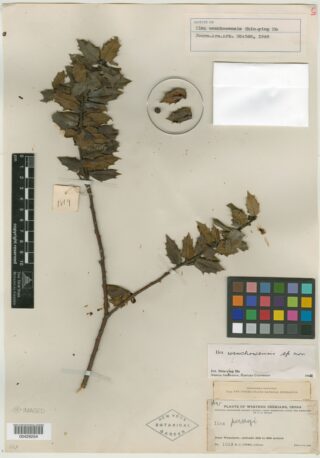
Bringing Asia to Digital Life: Mobilizing Underrepresented Asian Herbarium Collections in the US to Propel Biodiversity Discovery
Matthew Pace & Kathleen Armstrong
Asia is the largest continent on Earth, and includes the world’s tallest mountains, lowest landscapes, and habitats ranging from arctic tundra to tropical rainforests and mangroves to deserts. The plants of this region are incredibly diverse in their identities and functions. More than one-third of the world’s 350,000 plant species grow in Asia and include tiny alpine cushion plants, medicinal herbs, ancient crops, and some of the planet’s tallest rainforest trees. But documentation of this diversity remains inaccessible and research about it is difficult because most herbarium specimens of Asian plants have not been digitized. The All Asia Thematic Collections Network (TCN) will mobilize online 15 million specimens of Asian plants currently housed in the US and around the world. The project will especially focus on digitizing specimens from the unique and critically endangered biodiversity hotspots of Southeast Asia and the Himalaya-Hengduan region. These mobilized digital data will accelerate research to conserve endangered plant species and understand the interacting effects of evolution and global environmental change on plant species diversity. The project will apply state-of-the-art informatics tools and high-throughput digitization methods to efficiently and affordably digitize an unprecedented number of herbarium collections. This effort will connect and build long-lasting relationships among 25 large and small consortium institutions in the U.S., Europe, and Asia.
The focal areas from which specimens will be digitized encompass five biodiversity hotspots that include ~20% of the world’s vascular plant flora and historically spanned 3 million km² of primary vegetation that now covers less than 300,000 km². Fundamental biodiversity data for these biodiversity hotspots are lacking, along with the necessary baselines required to characterize species’ identity, range, and responses to ongoing climatic change. The overall goals of the All Asia TCN are to rapidly digitize herbarium specimens of Asian plants to advance biodiversity discovery and provide critical baseline assessments essential for establishing floristic change in the Anthropocene. The project will accomplish this by (1) digitizing 3 million Asian vascular plant specimens from U.S. herbaria; (2) developing and applying novel informatics tools and high-throughput digitization methods to massively scale herbarium digitization; (3) aggregating and mobilizing the digitized records from the project with those by international partners in China, France, the Netherlands, and Russia to establish a single online All Asia portal of ca. 15 million specimens; and (4) enhancing opportunities for early career learners in science, technology, engineering, and mathematics by stimulating synergies between biodiversity and computer scientists who will use design thinking principles to create real-world informatics solutions to biodiversity challenges. To stimulate curiosity in plant diversity and botanical exploration among the general public, the consortium members will host several Asia-themed Notes from Nature virtual expeditions to facilitate additional specimen digitization by citizen-scientists. Digitized specimen data mobilized through this project will be shared and made available through iDigBio.org.

Herbarium specimen of ilex wenchowensis, a holly endemic to China